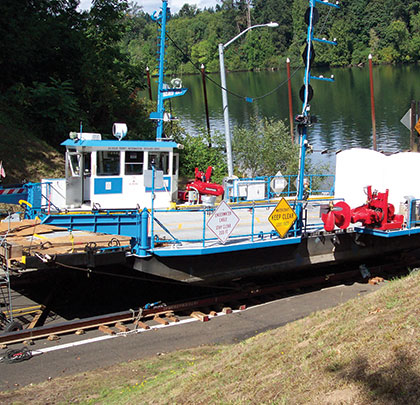Carrying people and goods across rivers by ferryboat is a two-century old form of transportation that existed long before modern bridges. But for Clackamas County, Oregon, three to four hundred automobiles use the county-owned Canby Ferry to cross the Willamette River every day, seven days a week. Annually, the ferry saves a long ride across the Canby town bridge for about 100,000 drivers taking business or pleasure trips to nearby wine country. To ensure the 300-foot (91.44 meters) crossing over the Willamette River goes smoothly and quietly, the ferryboat was recently upgraded to include two new, very modern electric motors—each of which is powered by a Danfoss VLT® AutomationDrive variable frequency drive.
ALL ABOARD THE M.J. LEE II
Christened the M.J. Lee II, the 84-foot (25.6 meters), steel-hulled, double-ended craft received the new variable frequency drives when it was completely refurbished in 2013. Before that, the ferry has a long history—a small wooden ferryboat was first put into service in 1914, then was replaced in 1953 with a steel-hulled vessel christened the M.J.
Lee. Following a retrofit in June 1997, the 160,000-pound (725,748 kilograms) vessel was rechristened the M.J. Lee II, with a capacity for 43 passengers and six automobiles.
Until the 2013 retrofit, the M.J. Lee II was powered by an electric-over-hydraulic propulsion system. “The goal of the retrofit was to create a quieter, more efficient system,” says Matt Bradford, general manager of Harbormaster Marine, the firm that produced the propulsion system for the recent retrofit. “The electric motors in the old system powered hydraulic pumps that drove a hydraulic motor on each propeller shaft. Because the drives are mounted amidships on each side of the vessel, hydraulic lines filled with pulsating fluid were in contact with the steel hull, which was very noisy for workers, passengers, and the local community.
“In addition to the noise, there were environmental concerns. The county wanted to reduce the need for frequent hydraulic fluid leak repairs and the risk of an oil spill.”
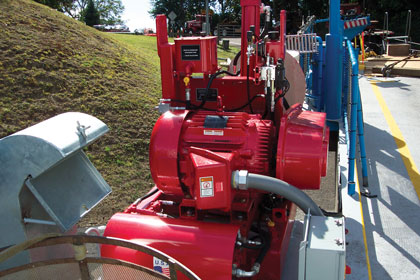
Each of the electric motors is powered by a Danfoss VLT® AutomationDrive variable frequency drive.
MIXING ELECTRICITY AND WATER IN A MARINE APPLICATION
The 2013 retrofit gave the M.J. Lee II an outboard drive consisting of two 75-horsepower AC induction electric motors linked to a Harbormaster mechanical drivetrain utilizing a gearset to rotate the propeller shaft. Hydraulics are not used to drive the propeller. Rather, instead of varying the flow of hydraulic fluid to change the propeller speed, the Danfoss VLT® AutomationDrives simply vary the frequency of the current, just as the drives would in a machine-automation application.
But an unusual consideration in this project was that machine applications do not usually deal with a mix of electricity and water. In this case, a 460-volt current from the electric grid is being supplied to the ferryboat to power two marine-duty electric motors. The electricity is transmitted by an overhead line system suspended in the air similar to the overhead wire used for a cable trolley. Essentially, a long extension cord, known as a “drop wire,” hangs down from the overhead line to the boat’s junction box. As the boat travels across the river, a pole containing the drop wire travels with it. The ferryboat travels at a maximum six knots following a submerged guide cable that holds the ferry in place under the power supply lines.
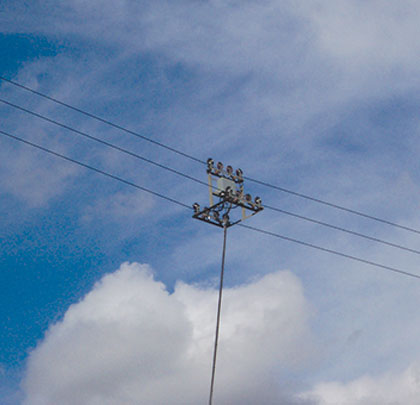
Electricity is transmitted by an overhead line system with a “drop wire” connected to the boat’s junction box.
From the junction box, the current goes through the drives’ harmonic filter, which prevents electrical noise from being transmitted back to the utility electrical system. Finally, the filtered current is transmitted to either the upstream or downstream motor at varying frequencies to control propeller RPM and direction.
The ferryboat pilot controls speed and forward and reverse propeller rotation using a joystick in a control console designed by Harbormaster Marine.
“I have to really credit Jud Utley of Brush Controls, the Danfoss representative in Michigan who supplied the drive, and Danfoss for their assistance,” says Bradford. “Harbormaster Marine has a long history in diesel bow thruster and outboard marine propulsion systems. This was our first variable frequency electric outboard drive. We had such good luck with Danfoss drives on our bow thrusters—which are used to turn props in vessels with a propeller in the bow, we figured, why not put them on an outboard drive?”
“Fortunately, the only challenge was discovering that our analog joystick control didn’t have a true neutral. When the joystick went into the middle detent position, we wanted to cut off motor current so the propeller wouldn’t turn. Jud was able to program the Danfoss drives and test them at our Michigan facility to verify true neutral before they went to the customer.”
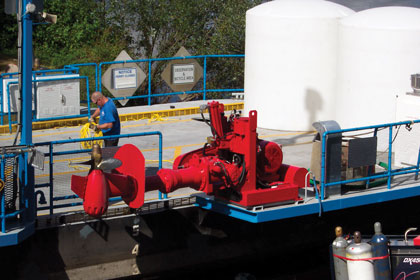
Danfoss drives come with a lot of marine certifications.
VARYING BOAT SPEED WITH FREQUENCY
Control of boat speed is critical during docking and vehicle loading and unloading. Maximum motor output is 1800 revolutions per minute driven through a gearbox that delivers a maximum propeller rotation of 550 revolutions per minute. Programmed to respond to the analog joystick’s position, the Danfoss drives can vary the motor’s frequency (Hz) from zero (0) Hz up to 60 Hz corresponding to 0 to 550 revolutions per minute propeller speed.
For Jud Utley, the Danfoss VLT® drives proved to be an ideal solution with the customizability to integrate with Harbormaster Marine’s drive and control configuration. “Danfoss VLT® drives have an intuitive and user-friendly local control panel that is easy to program,” he notes. “Plus, Danfoss also offered us great support to handle the console control challenge.”
The console’s joystick operates like a video game joystick, using a 4-20mA analog signal. The joystick’s position is critical to close relays that operate auxiliary equipment. Unfortunately, the joystick had a large deadband zone at the middle detent position. Utley showed drawings for the console to a Danfoss expert, who instructed Utley on the output parameters for forward and reverse that needed to be modified to get the joystick working. In just a half hour, Utley was able to program the drives’ logic sequencer and several analog inputs to get the joystick calibrated.
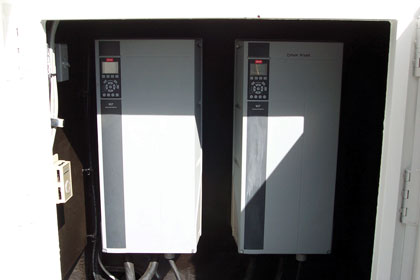
The Danfoss VLT® AutomationDrives vary the frequency of the current, just as they would in a machine-automation application.
“This was my first marine application for a variable frequency drive,” continues Utley. “I have a lot of experience with machine automation drives. As it happens, Danfoss drives come with a lot of marine certifications, which made them a natural fit for this application.”
The two drives are mounted amidships on the boat’s downstream side inside a waterproof locker. Two large fans on the roof of the locker circulate air. There also are two heaters in the locker. In the winter, the heaters run to handle moisture and cold weather, and in the summer, the fans run for cooling.
The external fans are compatible with the Danfoss VLT® AutomationDrive’s forced convection air circulation, which incorporates a fan that blows air through ribs of the aluminum base. The NEMA/UL Type 4X/IP 66 enclosure is built to handle harsh environments thanks to a manganic phosphor rear body. For further protection against the elements, the rear of the enclosure is dip-coated with epoxy or polyester spray finish; the cover is powder coated and uses a durable silicone gasket.
Throughout the harsh winter of 2013/2014, the M.J. Lee II ran steady as she goes with the Danfoss variable frequency drives. “It has proven to be a very clean, quiet system,” observes Bradford. “We’ve had zero issues. I am really quite impressed. There are other electric ferry applications in North America, and with the success of this retrofit installation, I am confident that Danfoss drives are a rugged, efficient, and silent solution that we can offer to propel these ferryboats into the future.” ■
About The Author
Jeff Duncan is marketing communications director for the Drives Division at Danfoss. Since 1968 Danfoss has been dedicated to developing VLT® variable frequency drives to control speed, torque, acceleration, synchronization, positioning, and the overall performance of AC motors. For more information, visit www.danfoss.com.
MODERN PUMPING TODAY, April 2015
Did you enjoy this article?
Subscribe to the FREE Digital Edition of Modern Pumping Today Magazine!


